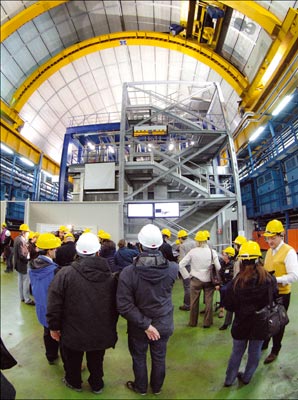
The experiment for Imaging Cosmic and Rare Underground Signals (ICARUS) was officially inaugurated on 29 March at the Gran Sasso National Laboratory (LNGS) of the INFN. The ceremony was attended not only by members of the ICARUS collaboration, but also by representatives from national and local authorities and companies involved in construction, as well as colleagues from other universities and institutes.

ICARUS started operating gradually from 27 May 2010 onwards. It has collected data from the start, recording the tracks of the rare cosmic rays that reach the laboratory, about 1400 m below the Gran Sasso massif and, above all, capturing interactions of the neutrino beam that travels some 700 km through the Earth’s crust from the CERN Neutrinos to Gran Sasso facility. The experiment will use the muon-neutrinos produced at CERN to study the phenomenon of neutrino oscillation, together with the OPERA experiment. In addition, ICARUS will study atmospheric neutrinos and those produced by the Sun, as well as events in the cosmos, such as supernovae explosions and the collapse of neutron stars. Another ambitious objective is the observation of nucleon decay.
ICARUS is the largest liquid-argon detector in the world, the culmination of 20 years of R&D in a project led by the Nobel laureate Carlo Rubbia, the spokesperson and “father” of the experiment. By using liquid argon to detect ionizing particles, the experiment can reconstruct charged-particle tracks and produce high-resolution images of interaction events in real time. Essentially a wire detector immersed in 600 tonnes of liquid argon, it records the passage of charged particles electronically, with the spatial and energy resolution of a bubble chamber, but more quickly.
The ICARUS collaboration comprises physicists from several sections of INFN and Italian university departments (L’Aquila, LNGS, Milan, Naples, Padua, Pavia) as well as groups of physicists from Poland, Russia and the US. The experiment was built in close collaboration with national industries. Cinel Strumenti Scientifici was responsible for the extremely refined mechanics of the detector, which has some 54,000 steel wires strung on huge frames of approximately 4 m × 18 m; the electronics were designed and constructed in collaboration with the CAEN Spa; and the cryostat and cryogenic systems were constructed in co-operation with Air Liquide Italia and Stirling, in the Netherlands.





